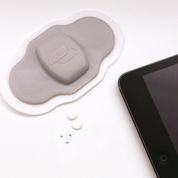Sensors in your stomach? Get ready for the next wave of medical diagnostics

It sounds like science fiction: you swallow your medicine and a tiny sensor embedded inside it sends vital health information about your body to your smartphone. Proteus Digital Health is among several companies on the cusp of making this type of scenario a reality, sooner than you might think.
"Half of medications will be digitized by 2020 -- that's our goal," says Arna Ionescu, vice president of user experience and design at Proteus, based in Redwood City, Calif. "Currently people have very minimal engagement with their health, and it's not working well, if you look at the trends in chronic illness. We're trying to make the process of taking medicine much richer."
According to studies cited in a 2011 report by the Network for Excellence in Health Innovation (NEHI), up to 50 percent of the nearly 200 million Americans on prescription medication don't take their medication as directed. An estimated $290 billion is spent each year because people don't correctly follow medication regimens.

The patch registers what time the medication was taken, as well as a patient's heart rate and activity and rest patterns, and sends this data wirelessly via Bluetooth to a smartphone app. The patient decides whether to share the information with family caregivers or a doctor.
The Proteus system, already available commercially on a small scale, is currently being used by family members wanting to keep tabs on loved ones with a chronic illness and doctors looking to better tailor care to a patient's needs, Ionescu says. "If a patient is taking their medicine more at night, for example, the doctor can switch them to a medicine that only needs to be taken at night," she says.
As part of a partnership with Oracle, the sensor is also being used to improve clinical drug trials by monitoring whether participants are taking medications correctly.
Currently, the Proteus sensor is ingested separately from medication, but Ionescu says Food and Drug Administration (FDA) clearance to incorporate the technology directly into prescription pills is not far off. Proteus is working with drug companies such as Otsuka Pharmaceutical and Novartis, and studies are under way involving drugs for hypertension and heart disease.
Proteus isn't the only company testing this sort of technology: Covidien GI Solutions makes PillCam, which helps diagnose problems in the small bowel and the colon; HQ Inc.'s CorTemp is an ingestible temperature monitoring system that helps prevent heat exhaustion in athletes and astronauts, and MicroCHIPS is working on an implantable microchip to deliver an osteoporosis drug that would normally require regular injections. Another approach that combines a sensor with a data-gathering device comes from MC10, which has designed an ultra-thin, wearable patch to help diagnose diseases.
Its Biostamp (pictured in the main image with this story) is a self-powered, film-like sticker that contains tiny batteries, memory and a microprocessor to measure physiological functions and transmit this data, like Proteus' sensor, wirelessly via Bluetooth to a smartphone app.
MC10 hopes to use the technology to help diagnose diseases such as epilepsy and Parkinson's, says Elyse Winer, manager of marketing and communications for MC10, based in Cambridge, Mass. "Today, doctors typically ask patients to manually track tremors in a diary," she says. "But this patch could measure duration, frequency and magnitude [of a tremor] and transfer that information to a caregiver."
Biostamp should be available to consumers later this year, and Winer predicts medical applications could be approved within the next couple of years.
MC10 envisions an even larger opportunity centered on applications for healthy individuals interested in keeping an eye on their vital signs. "We want to make getting personalized physiological feedback as routine as brushing your teeth or taking a shower," she says.
Of course, easy access to information of this nature comes with inevitable hazards. Jeremy Gillula, staff technologist at the Electronic Frontier Foundation, a digital privacy group, says health insurance companies may try to get access to personal health data or, down the line, offer lower rates in exchange for releasing information gained from a private health monitor. Hacking is always a danger, even though both Proteus and MC10 say they follow strict security protocols.
Despite his words of caution, Gillula notes: "I'd be surprised if we didn't see more usage of technology like this in the future ... if the dangers can be overcome, allowing people to monitor health conditions more regularly can be a very useful thing."
Images courtesy of MC10, Proteus
Related stories:
- London tests out smart, sensor-laden crosswalks
- Sensor swilling cattle can alleviate world hunger
- Even your toothbrush could be 'connected'
Sign up for our newsletter featuring in-depth business innovation stories by correspondents around the globe, top domestic reporters and thought-provoking opinion columnists.
This post was originally published on Smartplanet.com